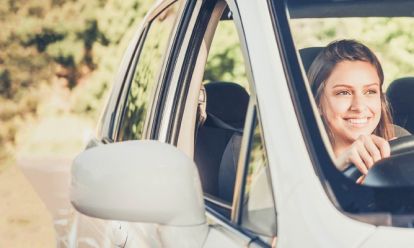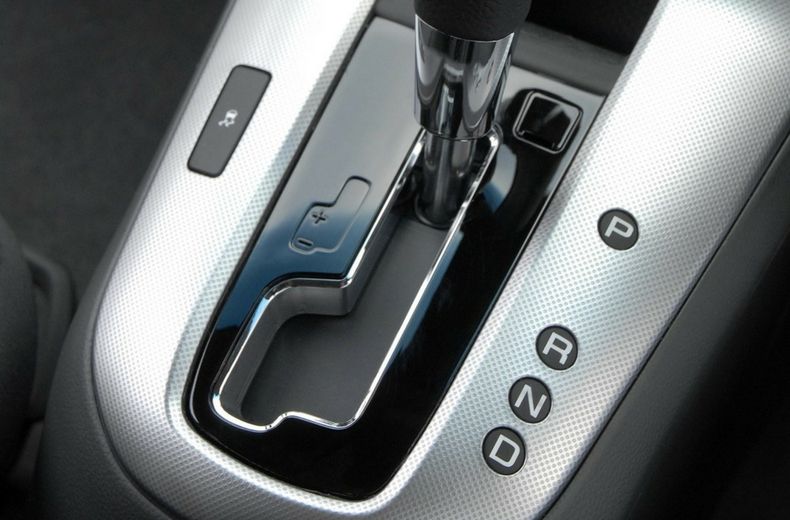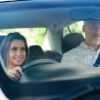Understanding how to drive an automatic car can be confusing as you get behind the wheel and become totally perplexed by the lack of a clutch pedal and the array of options provided by the shifter. However, as electric cars become more common place, automatic gearboxes could soon become the new normal for drivers in the UK.
That's why we've put together this step by step guide to help you understand how to start and drive an automatic car. And if you're looking to learn how to drive a manual car or help to pass the theory test - check out our quick and easy guide with pictures here.
How do automatic cars work?
Automatic cars work by changing the gears for you under normal driving conditions. Most automatic gearboxes will let you select between ‘P’ (for park), ‘R’ (reverse), ‘N’ (neutral) and ‘D’ (drive). Each gear simply does what it says. The only gear that is the same in a manual car is 'Reverse'.
- Park should only be used when you’re stopped and getting out of the car. This ‘locks’ the transmission, preventing it from rolling away (but you still need to apply the handbrake when parked as well).
- Reverse does as it says - acts the same as a reverse gear in a manual, and should be selected when you want to drive backwards.
- Neutral is the same as knocking a manual gearbox out of gear. It shouldn’t be selected when moving - this is known as coasting - but can be used (along with the handbrake) if you’re stopped for a short period of time.
- Drive will select gears automatically and allow the car to move forwards.
Some automatic gearboxes will also give you the option to select first or second gear.
This will help in situations where you want to use the gearbox to keep your speed down - such as driving down a steep hill.
Having this option also helps to keep the revs down and stop the wheels from spinning when pulling away in certain situations.
For instance when moving off in snowy or icy conditions it is sometimes advisable to pull away in second gear to stop the wheels from slipping if it is particularly snowy - some automatics also have a dedicated 'winter mode' that takes care of this.
You can read more about driving in adverse conditions on our driving in snow page.
The fact that a lever or selector takes the place of a gearstick in an automatic means that there are only 2 pedals: the accelerator and the brake. No clutch pedal to be found here.
Be careful not to instinctively press down on the brake pedal the way you would the clutch pedal in a manual! This will lead to an improptu emergency stop.
How to drive an automatic car
Although automatic gearboxes are generally very easy to use, the confusion comes when starting and stopping.
When you get into a car with an automatic gearbox, it is important to remember that you need to start the car and then keep your foot pressed on the brake pedal to shift the gear selector from park to drive or reverse. You should also ensure the gearbox is aways left park before you engage the handbrake and switch off the engine.
How to start an automatic car: step-by-step guide
Now that you know more about the workings of an automatic vehicle, you should be ready to get behind the wheel. Let’s begin with starting an automatic car.
- To start an automatic car, first put your right foot on the left-hand pedal (the brake) and push down
- Start the car by twisting the key or pressing start button
- With your foot still on the brake, move the shifter to ‘D’ (if you want to drive forward) or ‘R’ (if you want to reverse) and disengage the handbrake, which will either a lever or button usually next to the ger selector
- Lift your foot off the brake, this will cause most automatic vehicles to ‘creep’ forwards
- To gain speed, gently press your right foot down on the right pedal (the accelerator)
- Once moving, the gearbox will select the correct gear for the situation and do all the hard work for you
How to stop an automatic car: step-by-step guide
- As you reduce the speed, the automatic transmission will shift down in gears for you
- When you’ve finished your journey, press down on the brake pedal until the car stops
- While stationary, to park, keep your foot on the brake and shift the lever to ‘P’
- Apply the handbrake (either a lever or button usually next to the gear selector)
- Then turn the ignition off
In the image above, you will notice two other letters on the gear shifter.
The ‘S’ stands for Sports Mode. This will often lower a car’s suspension, increase the level of sensitivity to the throttle, and increase the speed of the vehicle’s acceleration. The car will often stay in a gear longer to maximise the level of speed.
The ‘L’ refers to Low Mode. This will tell the car to remain in a lower gear for more power and less speed. This will help with towing and steep slopes.

RAC sale – up to 33% off*
• Roadside cover from £5.29 a month†
• We get to most breakdowns in 60 mins or less
• Our patrols fix 4/5 breakdowns on the spot

The different types of automatic gearboxes
Although any car which changes gears itself without the driver having to use a clutch pedal is generally considered to be an automatic, there are in fact a number of different types of automatic gearboxes.
Conventional automatic gearboxes
These use a ‘torque-converter’ to do the job of the clutch, and are more refined than other automatic ’boxes, but will use more fuel than manuals.
Luxury cars such as the Range Rover and Volvo XC90 stick with a conventional automatic transmission - using as many as nine gears.
Continuously variable transmissions (CVT)
CVTs are popular in hybrid cars such as the Toyota Prius, as they do away with cogs in favour of a belt which acts as a single gear ratio.
As well as being more efficient and more reliable, they also make for a smoother drive as the car doesn’t have to skip between gears.
A downside is slower acceleration than other automatic gearboxes, and a loud, strained engine sound can occur if you attempt to make rapid progress.
- How to drive a manual car - a quick and easy guide with pictures
- How to pass your driving test - a full guide from novice to pro
- 15 Driving test tips to help you pass first time
Dual-clutch automatics
These types of gearboxes are similar to a conventional automatic gearbox, but two clutches (operated automatically) replace the torque converter.
They line up alternating gears, meaning the next ratio is prepared and allowing rapid gear changes.
They’re popular in VW Group cars - ranging from the DSG gearbox found in the Volkswagen Golf to the PDK used in Porsches.
Automated manual gearboxes
These aren’t as popular as they used to be, but are still used in cheaper cars such as the Skoda Citigo.
These act like a normal manual, but select gears automatically and operat the clutch by computer rather than using a pedal.
The downside of this is they can be a little jerky - just like a manual, there’s a small pause as the system works through gears.
What are the advantages of automatic gearboxes?
Although automatic gearboxes traditionally have a reputation for being high maintenance, they are more reliable than they used to be.
They also reduce the chance of parts going wrong - for example, if your clutch control isn’t perfect, you won’t wear out the clutch in an automatic car.
As well as being easier to drive, in some cases automatic versions of cars can actually be more efficient than their manual counterparts.
They can be faster, too - many dual-clutch transmissions in particular can change gears quicker than humans can, shaving crucial tenths of a second off the 0-62mph time.
Ideal for sporting a track day - you can read our beginner's guide to track days here.
Automatic cars are, however, usually more expensive to buy, which will not help your cause if you're a new driver already facing high insurance premiums.
If you are looking to save money on car insurance as a new driver, you might want to look into black box car insurance. Or you might want to consider temporary car insurance to cover you for borrowing a car.
Learner Driver Car Insurance
Only pay for the cover you need until you’ve passed your test. Get learner driver insurance so you can practice outside of your lessons.


Can I drive a manual car with an automatic licence?
No. If you have an automatic driving licence, you can only drive an automatic.
While it restricts the range of cars you can drive, some people find it easier to learn and subsequently pass their test in an automatic as it takes away a lot of the aspects of learning to drive some people struggle with, like clutch control and using the gears.
If, however, you have a manual licence, you can drive both manuals and automatics.
For more information on learning to drive, visit our learning to drive section.
Once you've passed your test, make sure that you purchase RAC breakdown cover to make sure that you're covered in the event that your vehicle breaks down.
Services we offer
Learning to drive in an automatic car
Learning to drive in an automatic car is a popular option with many learner drivers – however, there are some important points to consider.
In the same way it is for learners in manual cars, you'll need to apply for a provisional driving license, find a qualified driving instructor, and then take enough lessons to feel confident enough to pass your test.
The most important thing to consider, when looking to book automatic driving lessons, is that if you pass your test in an automatic car, your license will be restricted to only automatic vehicles.
This means that in the future, should you want a manual car, you will need to take and pass a manual test.
Is it cheaper to learn in an automatic car?
Depending on a variety of factors, learning to drive in an automatic car can more expensive than learning in a manual car.
Although fewer lessons should be needed to pass using an automatic car, it can often cost more per hour compared to manual lessons.
The other issue is that you will only be able to drive automatic cars, whereas manual learners can drive both options. This means that you could end up having to take more lessons and tests if you want to drive a manual in the future.
However, the cost of taking the physical driving test in the UK is generally the same for both manual and automatic cars. It is exactly the same for the theory test.
Automatic driving licence
For drivers in the UK, an automatic driving licence is a driving licence that restricts the holder to driving only automatic transmission vehicles.
If you pass your driving test using an automatic car, your licence will indicate this restriction.
























